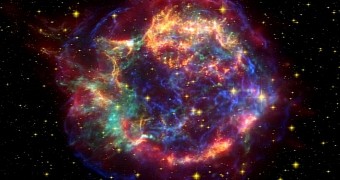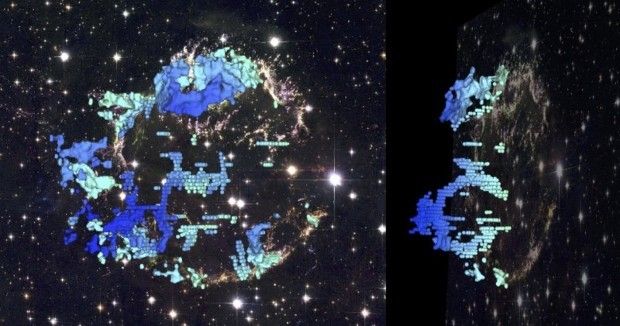Some 340 years ago, a massive star in the constellation Cassiopeia reached the end of its life and exploded in a supernova. Thus, the star simply broke apart and spilled massive amounts of insanely hot and radioactive matter into its surroundings.
In a paper published in today's issue of the journal Science, astronomers with the Harvard-Smithsonian Center for Astrophysics explain how, with the a telescope at the Kitt Peak National Observatory in Arizona, US, they managed to create a 3D model of the debris left behind by this stellar explosion.
Imaging a supernova remnant in 3D
Writing in the journal Science, astronomers Dan Milisavljevic and Rob Fesen explain that, to create a 3D model of Cassiopeia A, as this supernova remnant is known, they used the Mayall telescope at the Kitt Peak National Observatory to study it in near-infrared wavelengths of light.
This allowed them to map both the cavities and massive clouds of material that comprise Cassiopeia A, whose overall diameter is one of 10 light-years. Besides, the researchers managed to determine the speed at which the debris included in the supernova remnant's anatomy is now moving through space.
Having zoomed in on the cavities and the clouds of material inside Cassiopeia A and having also established the speed of the debris comprising it, the astronomers got to work putting together a 3D model of this supernova remnant. The end goal is to use this model to determine why the star exploded.
“Our three-dimensional map is a rare look at the insides of an exploded star,” said researcher Dan Milisavljevic. “We're sort of like bomb squad investigators. We examine the debris to learn what blew up and how it blew up,” the Harvard-Smithsonian Center for Astrophysics scientist added.
Cassiopeia A is kind of, sort of like Swiss cheese
As revealed in the images below, which show two distinct perspectives of the 3D reconstruction of the supernova remnant, Cassiopeia A is made up of about half a dozen massive cavities that appear to be connected to one another and that are intertwined with clouds of debris.
In fact, Dan Milisavljevic and Rob Fesen say that, at least as far as its anatomy goes, this supernova remnant kind of resembles a block of Swiss cheese. A mammoth block of cheese floating about in space 11,000 light-years from us and sporting holes 3 to 6 light-years in diameter, to be more precise.
If you have a few minutes to spare and happen to be in the mood to have a closer look at Cassiopeia A's entrails, check out the interactive 3D map the Harvard-Smithsonian Center for Astrophysics scientists behind this research project were courteous enough to share with us ordinary folks.

 14 DAY TRIAL //
14 DAY TRIAL // 

